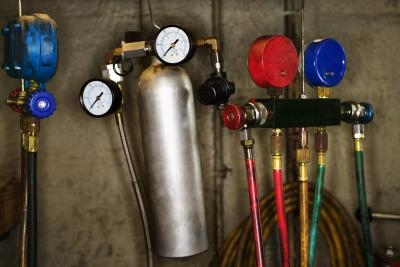
The 2001 Hyundai Accent is equipped with a durable and efficient air conditioning system. The heart of the system is the compressor that is mounted on the back of the engine. Sufficient skill and a knowledge of refrigerant recovery and recharging are critical to perform this task successfully. With a good approach and the right tools and equipment, this job can be completed in a few hours.
Recover the refrigerant. Raise the hood of the car and install a recovery system to capture the R134-A refrigerant in your Hyundai Accent's air conditioning system. Install both the low-pressure and high-pressure hoses from the machine onto the car service ports and pump the refrigerant from the car into the capture drum. Once the recovery cycle is complete, remove the hoses.
Raise the front of the car with a jack and place jack stands under the lower control arms where they attach to the front frame rails. Lower the car onto the stands and make sure the car is secure on the stands. From underneath the car, loosen the belt tensioner and remove the dedicated belt that drives the air conditioner compressor.
Remove the old compressor. Use a 3/8-inch socket to remove the back bolt that attaches the suction and discharge hoses to the compressor. Inspect the aluminum flange that is part of the hose assembly for the old refrigerant seal and remove it if it is stuck there. Unplug the wire connector that operates the compressor clutch. Remove the four bolts that secure the compressor to the engine block with the socket. Lower the compressor and work it out from underneath the car.
Prepare the new compressor for installation. Add new refrigerant oil to the compressor. Drain the old compressor by inverting it and allowing the oil to drip into a drain pan. Estimate the amount of drained oil and add that amount plus one ounce. The reason the added amount is used is because some oil will be in the refrigerant that was captured, and some oil will remain inside the compressor. Use only new oil from a closed container as refrigerant oil absorbs moisture which will harm refrigeration systems.
Install the new compressor. Work the compressor into place and hand-tighten all four bolts before securing them with the socket. The bolt alignment is very precise, and tightening one bolt, before the others are installed, will create alignment problems. Once in place, tighten the bolts in a criss-cross manner. Install the rear hose assembly with a new gasket in place. Plug in the compressor clutch connector and reinstall the belt.
Evacuate the system. Install air conditioner gauges to the high and low ports on the hoses and attach the center hose from the gauges to a vacuum pump. Allow the pump to run for a minimum of 30 minutes then close the gauge valves. Note the blue gauge and verify that it is reading in the vacuum zone and remaining steady. If it begins to rise, there is a leak, and atmospheric pressure is rushing into the air conditioning system. If there is a leak, repair it before proceeding.
Charge the system with refrigerant. The Accent uses close to 600 grams of refrigerant or roughly two small cans of R-134A refrigerant. Remove the center hose from the vacuum pump and connect it to a can tap. Pierce the can with the tap and open the blue valve--the suction side--of the manifold gauge. Allow the first can to completely drain into the system. Close the blue valve, attach the second can, pierce the can with the tap and open the valve. Drain the can into the system, start the car and turn on the air conditioner to its maximum setting. Allow the blue gauge to stabilize at 35 to 40 PSI, close the valve and remove the hoses from the car.